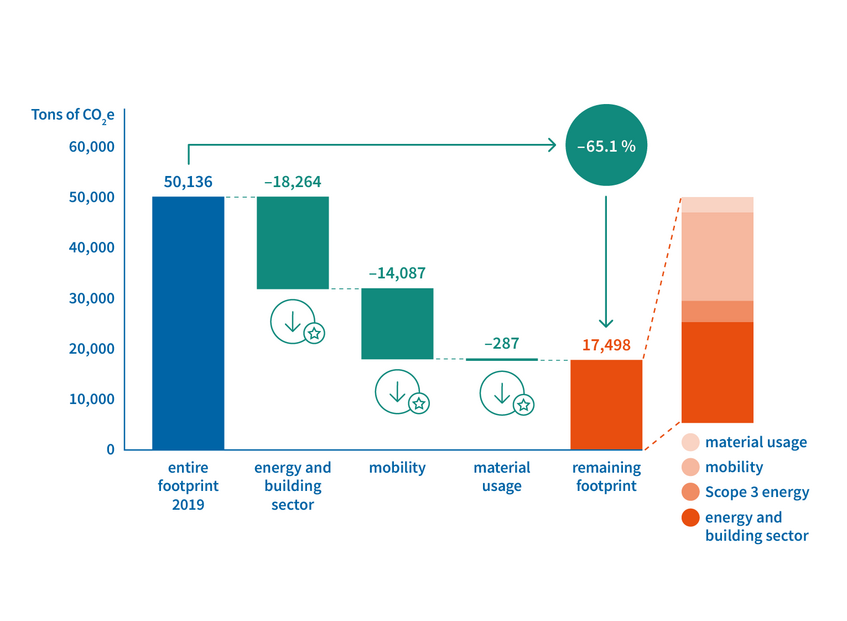Roadmap for climate neutrality
The University of Vienna contributes its share to achieving the climate targets of the Republic of Austria and the European Union and aims to achieve climate neutrality by 2030.
In the Paris Agreement, all countries of the world in 2015 agreed on keeping global warming significantly under 2 degrees Celsius, and if possible at 1.5 degrees Celsius. By striving for climate neutrality until 2030, the University of Vienna contributes its share to the Paris Agreement and to the climate neutrality objective of the Republic of Austria. In detail, this means that the University of Vienna intends to reduce at least two thirds of its greenhouse gas emissions until 2030 by implementing direct measures. The reduction by the remaining third should be reached through compensation measures. The reference year we use is 2019 (i.e. before the pandemic). Climate neutrality until 2030 is part of the Sustainability Strategy of the University of Vienna resolved in the autumn of 2021.

Overview roadmap for climate neutrality
To show the path towards a climate-neutral University of Vienna in 2030, we developed a roadmap. It is based on the first greenhouse gas emission balance of the University of Vienna (reference year: 2019) which takes into account emissions in the areas of energy consumption, mobility and use of resources. The roadmap shows the objectives, fields of action and measures for reaching climate neutrality.
The figure below illustrates the roadmap giving an overview of all areas.

Alt text: Bar graph. On the Y-axis: tons of CO2e (equivalents). on the X-axis the different sectors. Total footprint 2019: 50,136 tons; energy and building sector: 18,264; mobility sector: 14,087 t; material usage sector: 287 t; residual footprint to be offset: 17,498 t. remaining footprint consists of a small part of goods input, a large part of mobility, a small part of Scope3 energy and a large part of energy and buildings.
Roadmap: Sub-goals
To reach the overarching goal of reducing greenhouse gas emissions by two thirds until 2030, the following sub-goals have been defined:
Use of energy:
- Reducing GHG emissions in the area of energy usage by 67 % until 2030
- Reducing the use of energy by 28 % until 2030
- Changing to 100 % certified eco-power during the next tendering phase
Mobility:
- Reducing emissions resulting from business trips and stays abroad by 75 % until 2030
- Reducing emissions resulting from commuting by 50 % until 2030
Material usage:
- Reducing the new acquisition of paper and IT devices by 25 % until 2030
Reduction according to sectors
Use of energy
In total, the University produces 27,005 tons of greenhouse gases (calculated as CO2 equivalents) in the sector of energy usage every year. Almost half of it are caused by district heating (49 %) and electricity (46 %). With approximately 56 GWh, the annual electricity consumption of the University of Vienna corresponds to the electricity consumption of around 16,000 households. District heating consumption also amounts to around 56 GWh per year. To save more than two thirds of greenhouse gas emissions in the area of energy usage until 2030, the University of Vienna intends to emit 4,300 tons of greenhouse gases less per year through energy efficiency measures.
Measures in the area of energy efficiency that have already been implemented at the University of Vienna:
• Change of lighting to LEDs and change of light control at selected locations
• Feasibility study for photovoltaics on the roof of UZA II
• Evaluation of the time programmes in the area of heating/air conditioning control
• Usage of energy metres for the energy monitoring system
The following measures for reducing the use of energy at the University of Vienna are already being planned:
• Expanding the energy monitoring to additional locations
• Increasing energy efficiency of course and event rooms by adjusting the technical installations automatically to the booking situation
• Control of ventilation systems based on need and CO2 levels
• Installation of thermostatic valves in offices and general areas
• Building renovations should result in an additional reduction by approximately 4,200 tons of CO2.
The emission of greenhouse gases needs to be decreased significantly also in the area of electricity. In addition to reducing electricity consumption through energy efficiency measures, the University of Vienna primarily also wants to entirely change to green power subject to an eco-label (UZ46 Grünstrom) in two steps. The first step has already been made: Approximately half of the electricity consumed since early 2022 is UZ46-certified. Our energy monitoring system, which is currently providing information about the use of electricity, heat and water every 15 minutes, already provides a good overview of the use of energy at the University of Vienna. To monitor the measures, annual measure controlling is going to be introduced. This should guarantee that measures actually contribute to reducing the use of energy and that measures can be adjusted in due time, if needed.
All employees of the University of Vienna already have the opportunity to submit ideas for energy savings or defects via the ticket system.
Mobility
The topic of mobility consists of the commuting mobility and university-related stays abroad of employees and students (e.g. business trips of employees, excursions).
The lion’s share (58 %) of the greenhouse gas emissions caused by mobility are business trips and stays abroad of employees. Until 2030, three quarters of emissions resulting from business trips and stays abroad should be cut. A working group tasked by the Rectorate is currently working on concrete measures for reducing greenhouse gas emissions caused by mobility, especially in the area of business trips and stays abroad.
The University already defined corner stones for more sustainable business trips in the autumn of 2021. These, among others, allow employees to travel by train even if a flight would be cheaper. Employees can make their decision based on a flight decision tree.
Our students’ and employees’ commuting behaviour contributes to the University’s CO2 footprint to a significantly smaller extent. Also in this area, the University wants to reduce the related emissions by half until 2030.
To determine the effect of measures, data in the area of business trips and stays abroad should be centrally collected and analysed, if possible. Another mobility survey should provide information about changed mobility and commuting behaviour and input for an updated greenhouse gas balance.
Material usage
At the University of Vienna, materials (IT devices, paper, hygiene paper,...) are purchased decentrally in many areas. Therefore, we intend to prepare guidelines for the sustainable acquisition of materials that help employees when purchasing goods. The goal until 2030 is to reduce one quarter of the produced greenhouse gas emissions.
The ClimCalc Tool used for preparing the greenhouse gas balance only considers the acquisition of paper and IT devices in the area of material usage but not consumables in laboratories, for example. Although the reduction of the use of consumables therefore does formally not contribute to reaching the goals of 'reducing greenhouse gas emission by two thirds’ when using the ClimCalc Tool, we also intend to define measures in this area, e.g. through the support of the Green Labs Initiative, in which several research groups from several faculties are already participating. Here, one of the measures is to massively reduce the use of plastics in laboratories.
Compensation
Following successful implementation of all reduction measures, there is still a remaining footprint of about a third of the initial GHG emissions. These have to be compensated by suitable compensation measures to reach climate neutrality. The Compensation Working Group is developing a compensation strategy for the University of Vienna, taking into account the Roadmap 2030 and any further developments.
